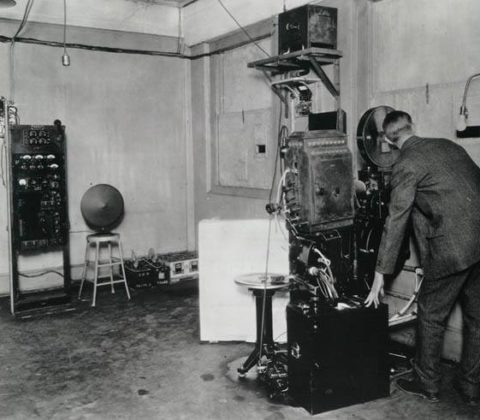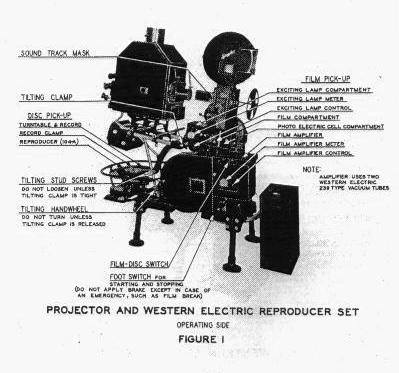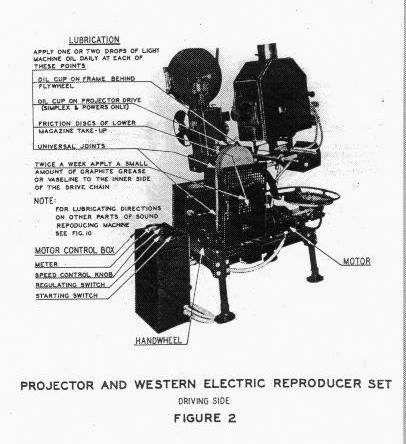

1926-2016…Celebrating 90 Years Of Talking Pictures
1926-2016…Celebrating 90 Years Of Talking Pictures
Thanks to Western Electric’s Vitaphone technology, moving pictures with sound became a commercial success, but the story does not start with “The Jazz Singer”, and it doesn’t even start with the spoken word.
Believe it or not, the very first sound with film efforts were thought of as a way to add some reality by including sound effects, and…and this is a big and…do away with the expense of hiring musicians to play an accompaniment to the film, by recording the music and sound effects together. Theater owners liked the idea of saving money on musicians, but passed because it would cost them money to install the system.
Vitaphone added sound via a turntable slaved to the projector. The 16″ discs played from “the inside to the outside” and had cue arrows on where to set the needle, with each disc starting at the head of each film reel. Notice in the photo below, there is a single projector, which was OK for shorts, but when feature length movies came around, twin projectors were needed.
Here is a brief history of how sound and film began their remarkable union. On April 20, 1926, Western Electric, the manufacturing arm of the American Telephone & Telegraph Company, and the Warner Brothers film studio officially introduced Vitaphone, a new process that enabled the addition of sound to film (but not “on film”).
By the mid-1920s, several competing systems had been developed to add sound to motion pictures. In 1923, inventor Lee de Forest demonstrated Phonofilm, in which music was recorded on a narrow strip at the edge of the film. When De Forest tried to sell Phonofilm to the major Hollywood movie studios, they rejected it, dismissing “talking pictures” as a novelty that was not worth the cost. De Forest’s sound-on-film system evolved into the Movietone sound process, introduced in 1927.
The major studios also turned away Western Electric, makers of Vitaphone, in 1925. The Vitaphone system logged sound on a record linked electronically to the projector, keeping sound synchronized with image. Because the precise alignment of projector and phonograph had to be set by hand, the system was prone to human error; fitting a movie theater for a Vitaphone sound system was also extremely costly. Warner Brothers, then a minor studio, decided to act aggressively. It sank $3 million into the promotion of Vitaphone, which the studio announced it would use to provide synchronized musical accompaniment for all its films.
Vitaphone debuted in August 1926 with the costume drama “Don Juan”, starring John Barrymore and featuring an orchestral score by the New York Philharmonic. The following year, Warner Brothers released its second Vitaphone feature, “The Jazz Singer”, which included classical and popular music, as well as about 350 words of dialogue.
The success of these two films led directly to the motion-picture industry’s conversion to sound, as the major studios quickly lobbied to gain the rights to use Vitaphone as well. Warner Brothers agreed to give up its exclusive rights to the system in exchange for a share of the royalties, and by the spring of 1928 virtually every Hollywood studio had jumped on the sound bandwagon, but not necissarly the Vitaphone wagon…
By then Lee de Forrest’s Movietone, sound on film process was more developed and debuted with “Steamboat Willie”. That was Disney’s first sound film, featuring Mickey Mouse whose animation was drawn by the beat of a metronome, with a fully-synchronized soundtrack of music and sound effects and dialogue, recorded optically as sound-on-film. The rest as they say, is history. -Bobby Ellerbee


Great information, as usual, Bobbie! Even before recorded sound, films were accompanied by sound from an orchestra, piano or pipe organ.
1913-2016, actually. The Kinetophone was 14 years earlier than Vitaphone but the same concept….
http://inventors.about.com/od/famousinventions/fl/Thomas-Edison-Kinetophones.htm
My dad worked in a movie theater in the 1920’s. I remember him telling me about playing the soundtrack from a record before they got “sound on film”.
so it must have been vitaphone that came up with the 33 1/3 RPM speed for playback of the audio on the vitaphone discs….the failed experiment for film because THE recording medium for radio from the late 1920s to the early 1950s….16 inch discs at 33 1/3 RPM….the radio transcription disc was the father of the vinyl LP
https://youtu.be/4yWXhpY76rU
Prod. still from “Voice from the Screen”